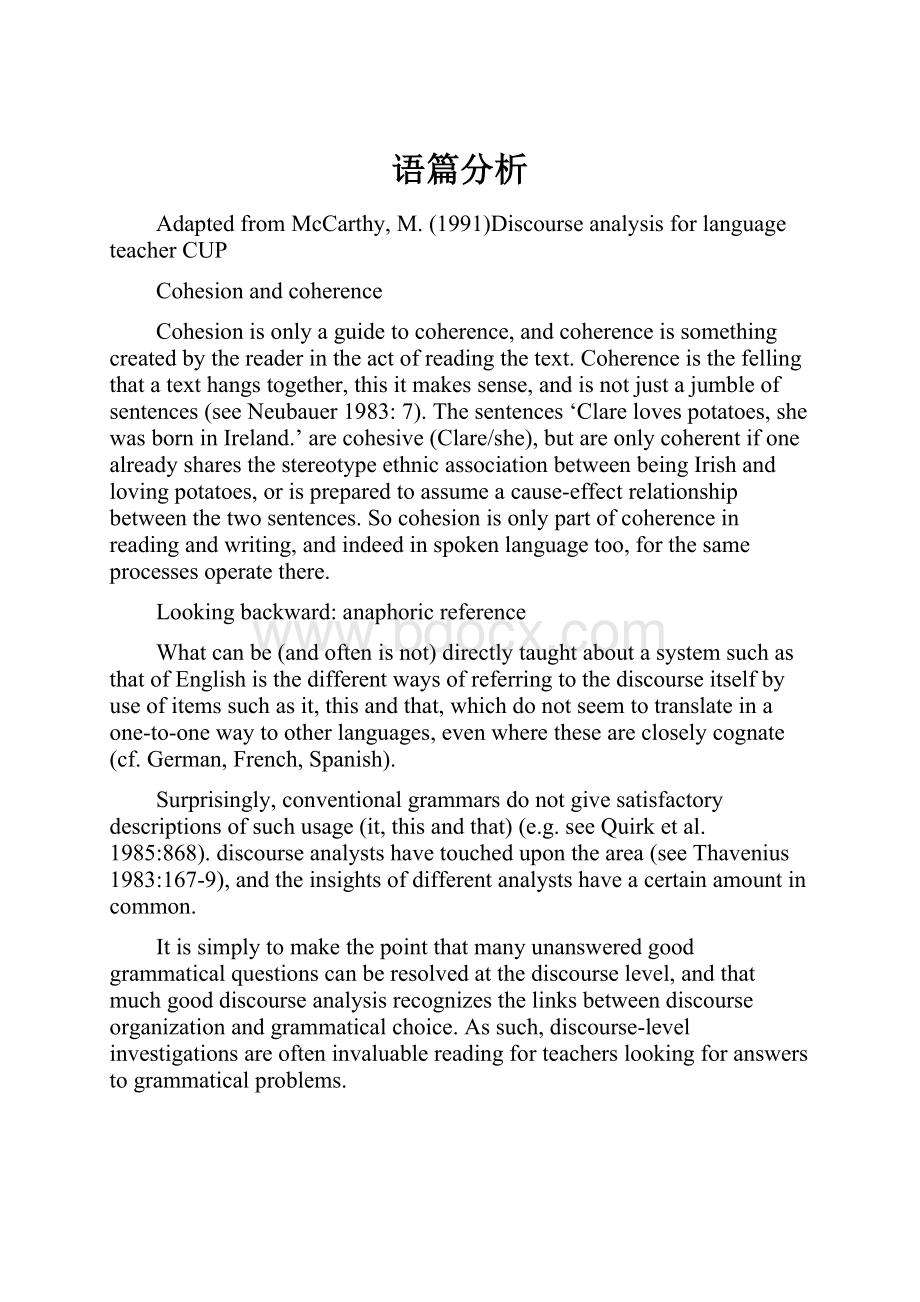语篇分析Word文档格式.docx
《语篇分析Word文档格式.docx》由会员分享,可在线阅读,更多相关《语篇分析Word文档格式.docx(49页珍藏版)》请在冰豆网上搜索。

7).Thesentences‘Clarelovespotatoes,shewasborninIreland.’arecohesive(Clare/she),butareonlycoherentifonealreadysharesthestereotypeethnicassociationbetweenbeingIrishandlovingpotatoes,orispreparedtoassumeacause-effectrelationshipbetweenthetwosentences.Socohesionisonlypartofcoherenceinreadingandwriting,andindeedinspokenlanguagetoo,forthesameprocessesoperatethere.
Lookingbackward:
anaphoricreference
Whatcanbe(andoftenisnot)directlytaughtaboutasystemsuchasthatofEnglishisthedifferentwaysofreferringtothediscourseitselfbyuseofitemssuchasit,thisandthat,whichdonotseemtotranslateinaone-to-onewaytootherlanguages,evenwherethesearecloselycognate(cf.German,French,Spanish).
Surprisingly,conventionalgrammarsdonotgivesatisfactorydescriptionsofsuchusage(it,thisandthat)(e.g.seeQuirketal.1985:
868).discourseanalystshavetoucheduponthearea(seeThavenius1983:
167-9),andtheinsightsofdifferentanalystshaveacertainamountincommon.
Itissimplytomakethepointthatmanyunansweredgoodgrammaticalquestionscanberesolvedatthediscourselevel,andthatmuchgooddiscourseanalysisrecognizesthelinksbetweendiscourseorganizationandgrammaticalchoice.Assuch,discourse-levelinvestigationsareofteninvaluablereadingforteacherslookingforanswerstogrammaticalproblems.
Lookingoutward:
exophoricreference
Exophoricreferenceswilloftenbetoaworldsharedbysenderandreceiverofthelinguisticmessage,regardlessofculturalbackground,butequallyoften,referenceswillbeculture-boundandoutsidetheexperiencesofthelanguagelearner(e.g.BritishreferencestheCity,theChancellorandsoon).Inthesecasesthelearnerwillneedtoconsultsomesourceofencyclopedicinformationoraskaninformant.ThisaspectoflanguagelearningisagradualfamiliarizationwiththeculturalcontextofL2.Languageteachersandmaterialswriterswillneedtomonitorthedegreeofculturalexophoricreferencesittextchosenforteachingtoensurethereferentialburdenisnottoogreat.
Lookingforward:
cataphoricreference
Themostcharacteristicfunctionofcataphoricreference:
toengageandholdthereader’sattentionwitha‘readonandfindour’message.p42
Cataphoricreferenceisthereverseofanaphoricreferenceandisrelativelystraightforward,gutlanguagelearnersmaylackawarenessofconfidencetoputitintouseinconstructingtexts,andmyneedtohavethefeatureexplicitlytaughtorexercised.Thereis,too,thedangerofitsoveruseoritsuseinunnaturalcontexts.Asalways,itisaquestionoftrainingthelearnertoobservefeaturesoflangueabovesentencelevelwherethesemightnotnecessarilybeautomaticallytransferredformL1,especiallysince,inEnglish,referenceofinvolvesthedefinitearticleanddemonstratives,whichdonottranslateeasilyintomanyotherlanguages.p42
Ellipsisandsubstitution
Ellipsisasanotinisprobablyauniversalfeatureoflanguagebutthegrammaticaloptionswhichrealizeitindiscoursemayvarymarkedly.P43
Ellipisisnotonlycreatesdifficultiesinlearningwhatstructuralomissionsarepermissible,butalsodoesnotseemtobereadilyusedevenbyproficientlearnersinsituationwherenativenaturallyresorttoit(seeScarcellaandBrunak1981).
Conjunction
Differencesinperformancedataofthesekindsareoftenthereasonwhyevenquiteadvanced-learneroutputcanseemunnatural.Oneofthemajorcontributionsofdiscourseanalysishasbeentoemphasistheanalysisofrealdata,andthesignificanceincommunicativetermsofsmallwordssuchascommoneverydaymarkers.Inpreviouslinguisticapproachestheseweretoooftendismissedasunimportantfeaturesof‘performance’whichdistractedformthebusinessodescribingunderlying‘competence’.p50
Themeandrheme
Grammarteachingmayhavetoreorientsomeofitsstructuraldescriptions,whileothersalreadydealtwithinsentence-levelexercisesmaybeadequatelycoveredintraditionalteachingandsimplyadjustedtodiscourse-orientedapproaches.P51
Themeandrheme
Patternsofsequencingofthemeandrhemearetendenciesratherthanabsolutes.Veryfewtexts(exceptperhapshighlyritualizedonessuchreligiouslitanies)repeatthesamethematisingpatternsendlessly.Wehavesuggestedthatlow-levellearnersmightbetrappedinunnaturalpatternsowingtolimitedgrammaticalresourcesorlackofconfidenceonanewL2,butmostadvancedlearnersarelikelytohaveagoodfeelforcreatingtopicframeworksandorientingtheiraudience.Thegrammaticalstructuresthatareunderplayedingrammarbooks(e.g.leftdisplacements,object-fronting)maybeproducedunconsciouslybylearners,butawarenessandmonitoringonthepartofteachersisnecessarytoensurethatnaturalproductionusingthewideresourcesofthgrammarisindeedtakingplace.P58
Lexicalcohesion
Itisimportanttomakelearnersawarethatsynonymsarenotjustwaysofunderstandingnewwordswhentheycropupinclass,noraretheysomeabstractnotionfortheorganizationoflexiconsandthesauri,buttheyaretheretobeused,justasanyotherlinguisticdevice,inthecreationofnaturaldiscourse.P67
Lexisintalk
Wefindthatinterestingobservationscanbemakeconcerninghowspeakersreiteratetheirownandtakeuponeanother’svocabularyselectionsinoneformoranotherfromturntoturnanddevelopandexpandtopicsindoingso.weshallrefertothisphenomenonasrelexicalisation.
Theintimatebondbetweentopicdevelopmentandthemodificationandreworkingoflexicalitemsalreadyusedmakestheconversationdevelopcoherently,seemingtomoveformsub-topictosub-topicasaseamlesswhole,inthisthescopeofthetopicsisworkedoutbetweentheparticipants,withneithersidenecessarilydominating,thisaccordswiththeethnomethodologicalapproachtodiscourseanalysis,whichseesconversationasajointactivitythathastobeworkedat.Topicsunfoldinteractively,ratherthan‘existing’asstaticentities;
Wardaugh(1985:
139-40)referstotopicasa‘consensualoutcome’.Thisisquiteclearlysohere.Speakerscanthrowtopicsintothering,butwhethertheyaretakenupordiedependsontheotherspeaker(s);
ifonespeakerinsisteronpursuinghis/hertopics,ignoringthewishesofothers,thisispreciselywhenwerecognizedevianceintomonologueorcomplainlatertoourfriendsthat‘Xwashoggingtheconversation’.Utterancesbyonespeakerareaninvitationtoresponsebyanother(seeGoffman1976);
theinitiatingutteranceputsanobligationontherespondingspeakertomakehis/herturnbothrelevanttopreviousturnandapositivecontributiontotheforwardmovingofthediscourse(seeVuchinich1977).Relexicalisationofsomeelementsofthepreviousturnprovidesjustsuchacontributiontorelevanceandprovidesotherimportant‘Iamwithyou’signalstotheinitiator.pp69-70
Exchanges
ParticularlynoticeableintheSinclair-Coultharddatawasthepatternofthethree-partexchangeintraditionalclassrooms,wheretheteachermaketheinitiationandthefollow-upmove,whilepupilswererestrictedtorespondingmoves.Inagoodmanylanguageclassesthisisstillthepattern,especiallyinsituationswherelargeclassesofperhaps40to50pupilsisthenorm.wherethishappensitislikelythatpupilswillhavethechancetopractiseonlyaveryimpoverishedrangeofutterancefunctions..insuchlanguageclassrooms,learnersrarelygettheopportunitytotakeotherthantherespondingrole,andeveningcaseswherestudentsareencouragetoinitiatethefollow-upmoveisoftenstillinthehandsoftheteacher,andlearnersgetlittleornopracticeinthisparticulardiscoursefunction.P123
Turn-taking
Thetraditionalclassroom,asobservedbySinclairandCoulthard,hasveryorderedturn-takingunderthecontroloftheteacher,andpupilsrarelyspeakoutofturn.Morerecenttrendsinclassroomorganization,suchaspairandgroupwork,attempttobreakthisrigidturn-takingpattern;
butdonotalwayssucceedinrecreatingmorenaturalpatterns.Oftentheproblemlies,asbefore,inactivitydesign.Weareallfamiliarwithroleplayswhereindividualsaresointentonformulatingtheircontributionsandmakingthematthe‘right’momentasdeterminedbytheactivityrubric,thattheypaylittleattentiontothecontributionsofothers,andthenaturalpatternsofback-channel,utterancecompletion,etc.simplydonotoccur.Theloosertherestrictionsonwhatandwhenpeoplemayspeak,themorenaturalturn-takingemerges.P.128
Studyofwritingasaculturalactivity
Connor,U.(1996)ContrastiveRhetoricCambridgeUniversityPressp21-22
InadiscussionofthedevelopmentofliteracyinL1andL2,Carson(1992)examineshowChineseandJapanesespeakerslearntoreadandwriteinL1andhowthatleaningaffectstheirexpectationsandstrategiesinlearningtoreadandwriteinL2.Carsonisconcernedabouttheinfluencesofsocialcontext,particularlytheeducationalsystem,andsheemphasizescognitiveconsiderationssuchasproblemspertainingtoorthographyinlearningtoreadandwriteinL1andlaterL2.ShebeginsbydescribinghowJapanesechildrenlearnoreadandwriteinasocietythatvalues“theimportanceofeducation(andofliteracy),theneedtoworkhardtosucceed,theinherentvaluesofthegroup,andtheprima